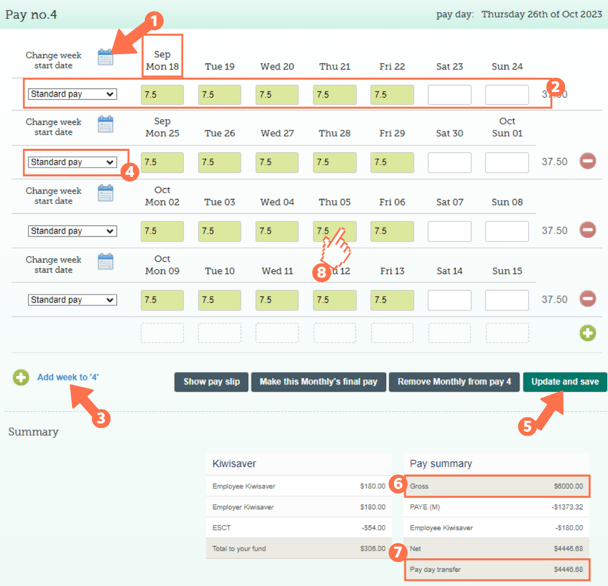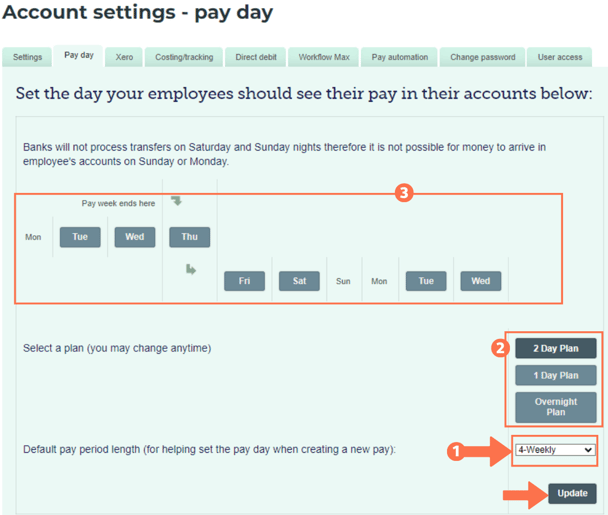Paying an Employee a 4-Weekly Salary
This article will show you how to set up a 4-weekly salary based on the number of workdays in the pay period.
Updated: September 2023
![]() Using the Monthly Calendar setting is the only way to pay the employee the same amount every month. If you wish to pay the same amount monthly, follow this link to our Help Article.
Using the Monthly Calendar setting is the only way to pay the employee the same amount every month. If you wish to pay the same amount monthly, follow this link to our Help Article.
When your salary is not based on a Calendar Month, the amount paid will differ each pay as it is based on the number of workdays in the pay period.
An example of this would be the 4-weekly salary. The salary could differ each month based on the number of workdays, but the value of each day will be the same.
Continue in this article to find the following:Paying a 4 Weekly Salary
![]() Using the 4-weekly pay will mean that the employee's pay could differ for every pay. What the system does is divide the Gross Annual Salary by the number of workdays, so the value of a day will be exactly the same from month to month.
Using the 4-weekly pay will mean that the employee's pay could differ for every pay. What the system does is divide the Gross Annual Salary by the number of workdays, so the value of a day will be exactly the same from month to month.
Setting up the Standard Pay Tab
In the example below, the employee is on a salary of $ 78,000 per year and will be paid on a workday-based cycle of 4 weeks. Their salary will vary depending on the number of workdays in the cycle. Each work day will be valued at $78000/260 workdays = $ 300 day value.
Let's investigate the Standard Pay Tab settings in their Employee Profile:
Complete the rest of the Employee Profile and SAVE the Profile Settings.
Now you are ready to add this employee to a pay.
Creating a Timesheet for a 4-Weekly Pay
Return to the dashboard to create a new pay. Toggle the employee's name on to create their timesheet.
![]() With a 4-weekly pay, the timesheet has to start from the first day of the pay period and include every workday up to (and possibly including) the last day of the 4 weeks included in the pay.
With a 4-weekly pay, the timesheet has to start from the first day of the pay period and include every workday up to (and possibly including) the last day of the 4 weeks included in the pay.
Let's have a look at an example timesheet:
- Start the timesheet from the first day of the pay period. If this is not the case, select the calendar next to the 'change week start date' heading and select the date from there.
- If you need to change the start date of the timesheet, you may have to change the pre-populated 'standard pay' row entries so they are correct. Please double check that these are correct.
- You will see that the first timesheet line is already pre-populated with the timesheet entries as set in the default setting of the Employee Profile. Check that these are correct - see (a) above. You will need to add more lines of the same kind to complete the full pay period in a single timesheet.
- In the bottom left of the timesheet, you will find the Green + sign 'Add week to (pay number)'. Click this to add a new line to the timesheet that will follow on in date.
- The Green + sign to the right of a timesheet row adds another row to this week (for sick leave for example or other pay types happening in the same calendar week).
- Select the 'standard pay' pay type from the dropdown box to the left of this new timesheet line.
- You will notice that the dates for these timesheet entries follow on from the previous line.
- This line should also pre-populate with the standard entries once you've selected the 'standard pay' pay type from the list.
- Continue to add lines to the timesheet and fill them in as you've just done till you reach the end of the pay period.
- Update and save the timesheet. Your timesheet boxes will be green when saved, as in the example.
- Check that the Gross amount is the expected salary, based on the number of workdays in the pay period.
- In this case we've calculated that a Gross Annual Salary of $ 78000 / 260 workdays for this employee = $300 per day. This pay period has 20 workdays, so 300 x 20 = $ 6,000 gross. This correlates with the gross amount in this timesheet.
- The pay day transfer amount is what the employee will receive in their bank accounts.
- You can bring up the costing screen and check the value of a single day by left clicking in a timesheet entry.
Shortcut options available with 4-weekly pays
- If all of your employees are paid 4 weekly, you can set your default pay period to 4-Weekly (1) in your pay day settings tab.
Whenever you then create a pay on the dashboard, simply set the pay period start date to the 1st day of your pay period (1) and click the default pay button (2).
- You can also automate 4-weekly pay cycles as long as your automatic payment to us comes on the same day of the month relative to your default processing plan.
For example: If your default pay day is the Thursday (3) following your pay period and you are on the 2-day slow processing plan (2) - your automatic payment should reach us by the Monday of payment week.
That is it! You have now successfully set up this employee to receive their salary every 4 weeks. As easy as that!


